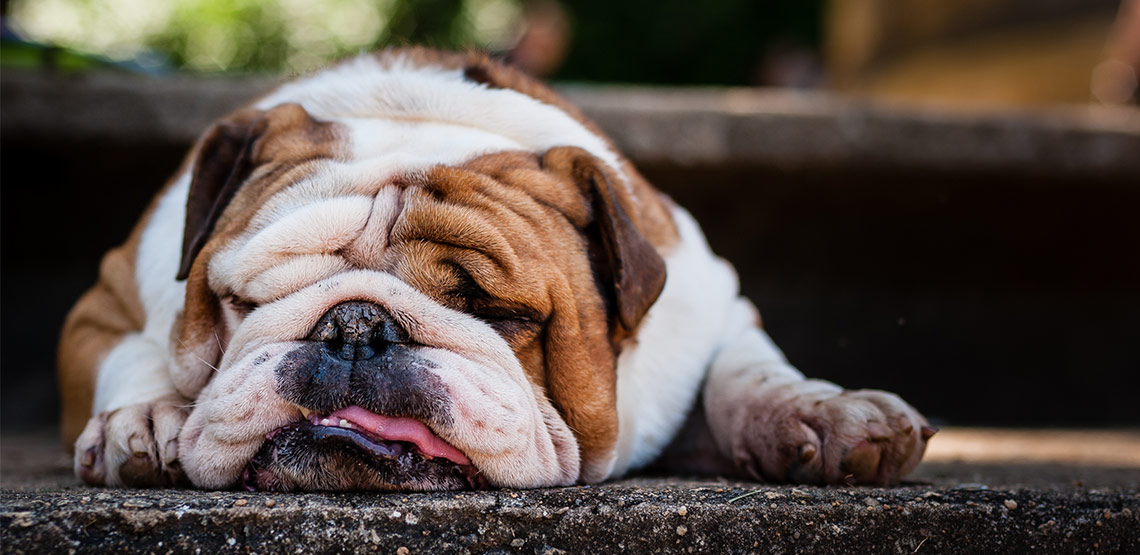A Complete Guide to the Bulldog
The bulldog is a strong, stern, dignified dog with three major recognized variants. The English bulldog is small in height but wide, thick and strong. Its stateside cousin, the American bulldog, is taller with a more slender build and narrower head. The French bulldog, commonly called the Frenchie, is considerably smaller than either the English or the American bulldog; it was bred for show and companionship, and is closer in size to a Yorkshire terrier than an English bulldog.
Appearance
Height: An English bulldog should range between 12 and 16 inches in height when fully grown. Interestingly, and unlike with many other breeds, dogs at the shorter end of the spectrum receive higher marks in dog shows. The American bulldog should grow much taller than this, roughly 20 to 28 inches at the withers in adulthood. French bulldogs are the stoutest of the three, standing at least a couple of inches shorter than their English counterparts.
Weight: A full-grown English bulldog should weigh roughly 50 to 55 pounds. A French bulldog that weighs more than 28 pounds will be disqualified from any American Kennel Club dog show. The American bulldog, being the tallest, is also the heaviest – an adult weighs between 75 and 125 pounds. This breed, much like the Boston terrier, is thickly muscled and strongly built, so these dogs often weigh more than they look like they should.
Coat: All bulldog variants have a short, fine, glossy coat. American bulldogs are usually white, fawn-and-white or fawn-and-brindle in color. English and French bulldogs are red, fawn, brindle, pale yellow, white or any combination of these colors. Black is not acceptable by AKC standards.
Ears and Eyes: The ears of both American and English bulldogs should be rose-shaped, thin, folded and relatively small. French bulldogs have sharper, taller ears, which are held erect. In all breeds, eyes are spaced fairly far apart, are round in shape and vary in color from light to dark.
Tail: English bulldog puppies show very short, low-hanging tails. Their French cousins have stubby tails, but American bulldogs have long, thin, whippet-like tails.
Disposition
English bulldogs are determined, persistent and territorial. While energetic in their youth, they tend to become inactive as they age. English bulldog breeders stress that these dogs can be quite aggressive with other animals, so they don't make good choices for multi-pet households. Their gruff tendencies make them a poor choice for homes with young children.
French bulldogs, having been bred for companionship, need considerable attention from their human friends. Gentle and happy-go-lucky, the French variant's only common behavioral issue is sexual aggression.
The American bulldog is gentle and friendly to known companions and outsiders who do not pose a threat. However, they can be testy towards cats and smaller dogs, so early socialization in multi-pet households is highly recommended.
AKC Group: Non-sporting (all variants)
You May Also Like:
Related Search Topics (Ads):
Training: It's important that the owner of any bulldog establish superiority over the dog very early in the animal's life, as behavioral issues will result if the dog considers itself the pack leader. Again, socialization with other animals and children from a young age is considered a wise practice.
Ideal Environment: Since they get cold easily and have a hard time staying cool in hot weather, English bulldogs are best suited to temperate climates. Despite their relatively large size, they prefer the indoors and make a good choice for apartment dwellers. French bulldogs are also excellent choices for apartment-dwelling pet owners.
American bulldogs, though, are larger and more energetic than the English and French variants, so they need a lot more room. A home with plenty of outdoor space is the best environment for these active animals.
Health and Care
Feeding: Feed your bulldog a diet that matches its activity level. Inactive bulldogs should have their food scaled back to prevent weight gain.
Grooming: The folds of a bulldog's face need to be wiped daily to release the germs and dirt that get trapped in them. Otherwise, this is a low-maintenance breed, requiring only brushing and the occasional bath.
Exercise: English and French bulldogs dogs are fairly inactive, though a good daily walk will help prevent weight gain. American bulldogs have a lot more energy and need, at minimum, a healthy burst of outdoor exercise each day.
Health Problems: Every dog breed faces specific health concerns. English bulldogs are susceptible to temperature extremes, skin infections and hip and knee problems. Breathing problems are also common, and English bulldog puppies and grownups alike tend to snore very loudly. Overweight, older adult dogs are at increased risk for diabetes and arthritis.
Many French bulldogs suffer from a hemophilia-like condition known as Von Willebrand's disease (VWD). French bulldogs also show a higher-than-average rate of thyroid problems.
Enlarged hearts, kidney disorders and thyroid troubles can plague American bulldogs. Hip dysplasia, elbow dysplasia and bone cancer also occur with significant frequency.
Average Lifespan: An English bulldog has a relatively short life expectancy, averaging about 8 years. Good dog nutrition can help extend your pet's life. The French bulldog has a life expectancy of about 12 years, and American bulldogs enjoy the greatest average longevity of the three variants, living 12 to 14 years.
Find Bulldog Puppies or Adult Dogs to Adopt
Breeders with English bulldog puppies for sale should be prepared to show certification of parentage and proper credentials. However, given the often exorbitant sale prices, bulldog adoption through a dog rescue center makes a good cost-cutting alternative. Expect breeders to charge between $750 and $1,000 for dewormed bulldog puppies that have had their first canine vaccinations.
Don't do business with puppy mills. These farms treat their animals poorly, subjecting them to living conditions that range from uncomfortable to awful.

